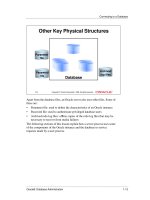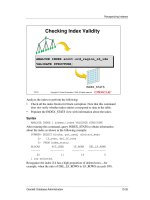security study guide phần 2 pot
Bạn đang xem bản rút gọn của tài liệu. Xem và tải ngay bản đầy đủ của tài liệu tại đây (6.08 MB, 11 trang )
110 Chapter 3
Infrastructure and Connectivity
Message Protocol (ICMP). This process adds additional complexity to the
process. DoS attacks present a challenge because flooding techniques are
used to overload the state table and effectively cause the firewall to shut down
or reboot.
Routers
The primary instrument used for connectivity between two or more networks is
the router. Routers work by providing a path between the networks. A router
will have two connections used to join the networks. Each connection will have
its own address and will appear as a valid address in its respective network.
Figure 3.4 illustrates a router being connected between a LAN and a WAN.
FIGURE 3.4 Router connecting a LAN to a WAN
Routers are very intelligent devices, and they store information about the
networks to which they are connected. Most routers can be configured to
operate as packet-filtering firewalls. Many of the newer routers also provide
advanced firewall functions.
Routers are also used to translate from LAN framing to WAN framing
(for example, a router that connects the 10BaseT network to the T1 network
shown in Figure 3.4). This is needed because the network protocols are
different in LANs and WANs. Such routers are referred to as border routers.
They serve as the outside connection of a LAN to a WAN, and they operate
at the border of your network. Like the Border Patrol of many countries,
they decide who can come in and under what conditions.
Dividing internal networks into two or more subnetworks is a common
use for routers. Routers can also be connected internally to other routers,
Network 1
Network 2
Router physically
isolates these two
networks.
Copyright © 2003 SYBEX Inc., 1151 Marina Village Parkway, Alameda, CA 94501. World rights reserved.
Devices 111
effectively creating zones that operate autonomously. Figure 3.5 illustrates a
corporate network that uses the combination of a border router for connection
to an ISP and internal routers to create autonomous networks for com-
munications. This type of connection keeps local network traffic off the
backbone of the corporate network and provides additional security to
internal users.
FIGURE 3.5 A corporate network implementing routers for segmentation and security
Routers establish communication by maintaining tables about destina-
tions and local connections. A router contains information about the systems
connected to it and where to send requests if the destination is not known.
These tables grow as connections are made through the router.
Routers communicate routing and other information using three standard
protocols (RIP, BGP, and OSPF). Routing Information Protocol (RIP) is a
simple protocol that is part of the TCP/IP protocol suite. Routers that use
RIP routinely broadcast the status and routing information of known
routers. RIP also attempts to find routes between systems using the smallest
number of hops or connections. Border Gateway Protocol (BGP) is a
relatively new protocol that allows groups of routers to share routing infor-
mation. Open Shortest Path First (OSPF) is a protocol that allows routing
information to be updated faster than with RIP.
Routers are your first lines of defense, and they must be configured to pass
only traffic that is authorized by the network administrators. In effect, a
router can function as a firewall if it is configured properly.
Internet
Border
Router
Internal
Private
Networks
Internal
Private
Networks
Internal
Private
Networks
Copyright © 2003 SYBEX Inc., 1151 Marina Village Parkway, Alameda, CA 94501. World rights reserved.
112 Chapter 3
Infrastructure and Connectivity
Switches
Switches are multiport devices that improve network efficiency. A switch
will typically have a small amount of information about systems in a network.
The use of switches improves network efficiency because of the virtual
circuit capability. Switches also improve network security because the
virtual circuits are more difficult to examine with network monitors. You
can think of a switch as a device that has some of the capabilities of routers
and hubs. The switch maintains limited routing information about systems in
the internal network and allows connections to systems like a hub. Many
modern hubs also provide switching capabilities. Figure 3.6 shows a switch
in action between two workstations in a LAN. The connection is not usually
secure nor is it encrypted; however, it does not leave the switched area and
become part of the overall broadcast traffic as typically found on a star-
based or bus-based LAN.
FIGURE 3.6 Switching between two systems
Wireless Access Points
The primary method of connecting a wireless device to a network is with a
wireless portal. A wireless access point is a low-power transmitter/receiver, also
known as a transceiver, which is strategically placed for access. The portable
device and the access point communicate using one of several communications
protocols including IEEE 802.11 (also known as Wireless Ethernet).
Wireless communications, as the name implies, do not use wires as the
basis for communication. Most frequently, they use a portion of the Radio
Frequency (RF) spectrum called microwave. Wireless communication methods
are becoming more prevalent in computing because the cost of the transmit-
ting and receiving equipment has fallen drastically over the last few years.
Wireless also offers mobile connectivity within a campus, building, or even a
city. Most wireless frequencies are shared frequencies, in that more than one
person may be using the same frequency for communication. Figure 3.7
illustrates a wireless portal being used to connect a computer to a company
PC PC
Switch
Private Circuit Private Circuit
Copyright © 2003 SYBEX Inc., 1151 Marina Village Parkway, Alameda, CA 94501. World rights reserved.
Devices 113
network. Notice that the portal connects to the network and is treated as any
other connection used in the network.
FIGURE 3.7 Wireless access point and workstation
Wireless communications, although convenient, are not usually secure.
Virtually any police scanner can be used to intercept the frequencies that
wireless access points use. Connecting the output from the scanner to the
audio port on a PC, using very inexpensive software, and decoding wireless
communications is a relatively straightforward proposition. If wireless
portals are installed in a building, the signals will frequently radiate past the
inside of the building, and they can be detected and decoded outside of
the building using very inexpensive equipment. Most of the newer wireless
controllers use special ID numbers and must be configured in the network
cards to allow communications. Using ID number configurations does not
necessarily prevent wireless networks from being monitored.
Never assume that a wireless connection is secure. The emissions from a
wireless portal may be detectable through walls and for several blocks from
the portal. Interception is extremely easy to accomplish given that RF is the
medium used for communication. Newer wireless devices offer data security.
If this is available, it should be used.
Internet
PCPC
Antenna
Laptop PC
Network
Access Portal
Wireless Server
Or
802.11 Card
LAN
RF Signal
Copyright © 2003 SYBEX Inc., 1151 Marina Village Parkway, Alameda, CA 94501. World rights reserved.
114 Chapter 3
Infrastructure and Connectivity
Modems
A modem is a hardware device that connects the digital signals from a
computer to the analog telephone line. It allows these signals to be transmitted
longer distances than are possible with digital signals. The word “modem”
is an amalgam of the words “modulator” and “demodulator,” which are the
two functions that occur during transmission.
Modems present a unique set of challenges from a security perspective.
Most modems will answer any call made to them when connected to an
outside line. Once the receiving modem answers the phone, it will generally
synchronize with a caller’s modem and make a connection. A modem, when
improperly connected to a network, can allow instant unsecured access to
the data and resources in a system or network. Many of the PCs being built
and delivered today come standard with internal modems. If a physical security
breach occurs, a modem can be used as a remote connection to your network
that allows unrestricted access. This can occur with no knowledge on the
part of the owner of the system or the network administrators. Modems,
unless specifically needed, should be disabled or removed completely from
network workstations. If this is not possible, they should be configured so as
not to auto-answer incoming calls.
Many preconfigured administrative systems provide modem connections
for remote maintenance and diagnostics. These connections should be either
password-protected or have a cut-off switch so that they do not expose your
network to security breaches.
Remote Access Services
Remote Access Services (RAS) is a product offered by Microsoft on Windows-
based products to facilitate the process of connecting two computers via a
modem or other connection over a long distance. You will encounter the
term RAS used interchangeably to describe both the Microsoft product and
the process of connecting remote systems. Figure 3.8 depicts a dial-up
connection being made from a workstation to a network using a RAS server
on the network. In this case, the connection is being made between a Windows-
based system and a Windows Server using POTS (Plain Old Telephone
Service) and a modem.
Copyright © 2003 SYBEX Inc., 1151 Marina Village Parkway, Alameda, CA 94501. World rights reserved.
Devices 115
FIGURE 3.8 A RAS connection between a remote workstation and a Windows server
The RAS connection is accomplished via dial-up or network technologies,
such as VPNs, ISDN, DSL, or cable modems. RAS connections may be secure
or in the clear, depending on the protocols that are used in the connection.
Telecom/PBX Systems
Telecommunications or telecom capabilities have undergone radical changes
in the last 10 years. The telephone systems and technologies available to deal
with communications have given many small businesses fully integrated
voice and data services at very reasonable prices.
These changes have complicated the security issues that must be handled.
One of the primary tools in communication systems is the Private Branch
Exchange (PBX) system. PBX systems now allow users to connect voice,
data, pagers, networks, and almost any other conceivable application into a
single telecommunication system. In short, a PBX system allows a company
to be its own phone company.
The technology is developing to the point where all communications
occur via data links to phone companies using standard data transmission
technologies, such as T1 or T3. This means that both voice and data com-
munications are occurring over the same network connection to a phone
company or a provider. This allows a single connection for all communications
to a single provider of these services.
Modem
Modem
POTS Connection
Workstation or Server
Running Remote Access
Copyright © 2003 SYBEX Inc., 1151 Marina Village Parkway, Alameda, CA 94501. World rights reserved.
116 Chapter 3
Infrastructure and Connectivity
Potentially, your phone system is a target for attack. Figure 3.9 shows a
PBX system connected to a phone company using a T1 line. The phone
company, in this drawing, is abbreviated CO (Central Office). The CO is
where the phone company systems that deal with routing and switching of
calls and services exist.
If your phone system is part of your data communication network, an
attack on your network will bring down your phone system. This can cause
the stress level in a busy office to increase dramatically.
The problems of security in this situation also increase because now you
must also work to assure security for your voice communications. No
incidents of phone systems being attacked by malicious code have been
reported yet, but such attacks will probably become a concern in the near
future.
FIGURE 3.9 A modern digital PBX system integrating voice and data onto a single network
connection
Imagine if you will that someone left a voice message for the president of your
company. A phreaker (someone who abuses phone systems, as opposed to
data systems) might intercept this message, alter it, and put it back. The
results of this prank could cause a calamity for the company (or at least you).
Make sure that the default password is changed after the installation has
occurred on the maintenance and systems accounts.
Digital
Switch
Data
Storage
T1
CO
Digital
Voice
Interface
Data
Interface
Analog
Voice
Interface
Copyright © 2003 SYBEX Inc., 1151 Marina Village Parkway, Alameda, CA 94501. World rights reserved.
Devices 117
Virtual Private Network
A Virtual Private Network (VPN) is a private network connection that
occurs through a public network. A private network provides security over
an otherwise unsecure environment. VPNs can be used to connect LANs
together across the Internet or other public networks. A VPN requires either
special hardware to be installed or a VPN software package running on
servers and workstations. With a VPN, the remote end appears to be con-
nected to the network as if it were connected locally.
VPNs typically use a tunneling protocol such as L2TP, IPSec, and PPTP.
Figure 3.10 shows a remote network being connected to a LAN using the
Internet and a VPN. This connection appears to be a local connection, and
all message traffic and protocols are available across the VPN.
FIGURE 3.10 Two LANs being connected using a VPN across the Internet
VPNs are becoming the connection of choice when establishing an Extranet
or Intranet between two or more remote offices. The major security concern
when using a VPN is encryption. PPTP offers some encryption capabilities,
although it is weak. IPSec offers higher security, and it is becoming the
encryption system used in many secure VPN environments.
Even though a VPN is created through the Internet or other public network,
the connection logically appears to be a part of the local network. This is why
a VPN connection used to establish a connection between two private net-
works across the Internet is considered a private connection or an Extranet.
ServerClient
Local Network
Internet
VPN channel
appears dedicated.
Local Network
Copyright © 2003 SYBEX Inc., 1151 Marina Village Parkway, Alameda, CA 94501. World rights reserved.
118 Chapter 3
Infrastructure and Connectivity
Network Monitoring and Diagnostics
Network monitoring is an area as old as data communications. Network
monitoring is the process of using a data-capture device or other method to
intercept information from a network. Network monitors come in one of
two forms. This section will introduce you to network monitors, commonly
referred to as sniffers, and Intrusion Detection Systems (IDS). These tools
allow you to examine the actual activity on your network or, in the case of
an IDS, add intelligence to the process, monitor system logs, monitor suspi-
cious activities, and take corrective action when needed.
The concepts of network monitoring and IDS are briefly covered here, and
they are covered in greater detail later in the book in Chapter 4, “Monitoring
Communications Activity.”
Network Monitors
Network monitors, otherwise called sniffers, were originally introduced to
help troubleshoot network problems. Simple network configuration programs,
like IPCONFIG, do not get down on the wire and tell you what is physically
happening on a network. Examining the signaling and traffic that occurs on a
network requires a network monitor. Early monitors were bulky and required
a great deal of expertise to use. Like most things in the computer age, they
have gotten simpler, smaller, and less expensive. Network monitors are now
available for most environments, and they are very effective and easy to use.
Today network-monitoring systems usually consist of a PC with a NIC
card and monitoring software. This monitoring software is menu-driven, is
easy to use, and has a big help file. The traffic displayed by sniffers can
become overly technical and require additional technical materials. You can
buy these materials at most bookstores, or you can find it on the Internet for
free. With a few hours of work, most people can make network monitors
work efficiently and use the data they present.
Sniffer is a trade name like Kleenex. It’s the most well-known network
monitor, so everyone started calling network monitoring hardware “sniffers.”
Intrusion Detection Systems
Intrusion Detection Systems (IDS) have been marketed as the ultimate and
final answer to network security. An IDS is software that runs on either
Copyright © 2003 SYBEX Inc., 1151 Marina Village Parkway, Alameda, CA 94501. World rights reserved.
Devices 119
individual workstations or on network devices to monitor and track network
activity. Using an IDS, a network administrator can configure the system to
respond just like a burglar alarm in your building. IDS systems can be con-
figured to evaluate systems logs, look at suspicious network activity, and
disconnect sessions that appear to violate security settings.
The technology shows great promise, but it is still relatively new. Many
vendors have oversold the simplicity of these tools. They are quite involved
and require a great deal of planning and maintenance to work effectively.
Many manufacturers are selling IDS systems with firewalls, and this area
shows great promise. Firewalls by themselves will prevent many common
attacks, but they do not usually have the intelligence or the reporting
capabilities to monitor the entire network. An IDS, in conjunction with a
firewall, allows both a reactive posture with the firewall and a preventative
posture with the IDS. Figure 3.11 illustrates an IDS working in conjunction
with a firewall to increase security.
FIGURE 3.11 An IDS and a firewall working together to secure a network
In the event the firewall is compromised or penetrated, the IDS system can
react by disabling systems, ending sessions, and even potentially shutting
down your network. This provides a higher level of security than either
device provides by itself. If it helps, think of the IDS/firewall combination as
a camera and a safe. The safe prevents many burglars from gaining access,
and the camera catches them in the act.
Prevents
Access
Network
Safe
Monitors
Intruders
IDS System
Internet
Router
Video Camera
Firewall
Copyright © 2003 SYBEX Inc., 1151 Marina Village Parkway, Alameda, CA 94501. World rights reserved.
120 Chapter 3
Infrastructure and Connectivity
Workstations
Workstations are particularly vulnerable in a network. Most modern work-
stations, regardless of their operating systems, communicate using services
such as file sharing, network services, and applications programs. Many of
these programs have the ability to connect to other workstations or servers
to work.
These connections are potentially vulnerable to interception and exploi-
tation. The process of making a workstation or a server more secure is called
platform hardening. The process of hardening the operating system is
referred to as OS hardening. OS hardening is a part of platform hardening
that deals only with the operating system. Platform hardening procedures
can be categorized into three basic areas:
The first area to address is removing unused software, services, and
processes from the workstations, (e.g., as the server service from a
workstation). The services and processes may create opportunities for
exploitation.
The second area involves ensuring that all services and applications
are up-to-date (including available service and security packs) and
configured in the most secure manner allowed. This may include
assigning passwords, limiting access, and restricting capabilities.
The third area to address involves the minimization of information
dissemination about the operating system, services, and capabilities of
the system. Many attacks can be targeted at specific platforms once the
platform has been identified. Many operating systems use default
account names for administrative access. If at all possible, these
should be changed.
Users Installing Unauthorized Software
Your Information Systems (IS) department is screaming about the amount of
unauthorized software that is being installed on many of the Windows 2000
systems on your network. What advice can you offer them on how to min-
imize the impact of this software?
Copyright © 2003 SYBEX Inc., 1151 Marina Village Parkway, Alameda, CA 94501. World rights reserved.









